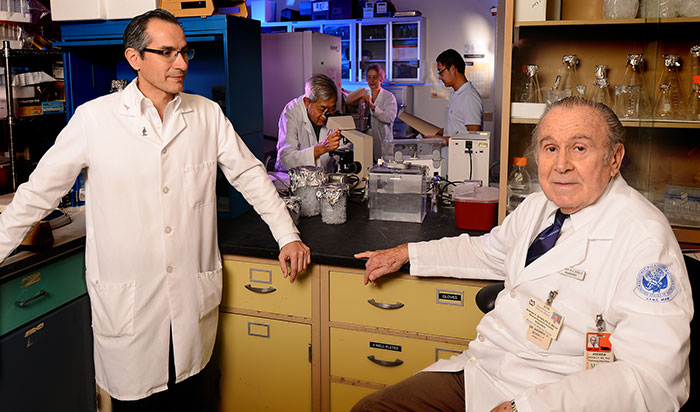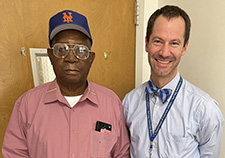Office of Research & Development |
 |


Dr. Andrew Schally (right) is seen in this 2013 Miami VA photo with his former lab manager, Ricardo Rincon. (Photo by Larry Gilstad)
November 6, 2018
By Mitch Mirkin
VA Research Communications

Growth hormone-releasing hormone, which has been the subject of much of Dr. Andrew Schally's research over the years, originates in the brain's hypothalamus. (Illustration: ©iStock/decade3d)
A lab team led by Nobel Prize winner Dr. Andrew Schally at the Miami VA Healthcare System and the University of Miami showed that a synthetic compound based on a brain hormone spurred the growth of cancer cells in Petri dishes but enigmatically had the opposite effect in mice.
The surprising discovery, reported in the Proceedings of the National Academy of Sciences (PNAS), holds promise for cancer treatment. But it is also important because the manmade compound and others like it have shown beneficial effects in preclinical studies to treat a range of medical conditions affecting the heart, pancreas, eyes, and other organs. That’s because the compounds spur the growth of new healthy tissue. Tests in animal models suggest, for example, that they could help grow new heart muscle cells after a heart attack.
The compound tested in the new PNAS report, MR409, is one of several patented analogs, or derivatives, made in Schally’s lab based on growth hormone-releasing hormone, or GHRH. GHRH is made in the brain’s hypothalamus. It triggers the production and release of growth hormone in the pea-sized pituitary gland, located near the base of the brain. Growth hormone, in turn, is essential for human growth and cell regeneration.
The fear among Schally and his scientist peers, though, was that while GHRH analogs might be potent medicine for some conditions, they might at the same time cause cancer cells to grow, due to their growth-stimulating properties.
"I'm not a clinician, but now I have no reservation in recommending the agonists for various clinical uses."
“I was concerned,” says Schally. “GHRH, in addition to being a brain hormone, is a powerful growth factor. I was afraid it would be stimulatory to tumors. Imagine us using it in patients with heart disease or diabetes and seeing cancers appear. That would make it completely unacceptable as a therapy.”
That’s precisely what MR409 did when applied to cell cultures in the latest experiments: It caused lung cancer cells from human tumors to multiply and spread, and kept them from dying.
But the hormone analog had the opposite effect when injected into mice with implanted human tumors: Not only did the compound not feed the cancer cells, it caused them to stop growing. It had this effect on lung, pancreatic, gastric, bladder, prostate, breast, and colorectal cancers. The analog, paradoxically, worked like counterpart analogs known as antagonists that are designed to block, not mimic, the action of GHRH.

VA researchers using AI to decide best treatment for rectal cancer

VA center training the next generation of researchers in blood clots and inflammation

AI to Maximize Treatment for Veterans with Head and Neck Cancer

Veterans help find new cancer treatments
“These are very welcome findings,” notes the VA Nobelist. “They may alleviate serious concerns about stimulating growth of cancers with GHRH agonists in the course of therapy for other diseases and conditions.”
Agonists are analogs that act like a key in a lock to initiate a biochemical reaction in the body. In the key-lock analogy, the lock is a receptor—a protein on the cell surface that interacts with the agonist to trigger a reaction. Antagonists, on the other hand, jam up the receptor so no reaction can occur. GHRH antagonists have been tested extensively by Schally’s group and others for their ability to inhibit tumors.
Schally and his team believe the most likely reason for MR409’s tumor-inhibitory effect in mice is the down-regulation of GHRH receptors in the pituitary gland and in the tumors themselves. That effect, which can occur only in live animals and not in isolated cells, may explain the dramatic difference between the analog’s effect in cells versus in the organism.
“The receptors transmit the hormonal message,” explains Schally. “When there are fewer receptors on the cell surface, this blocks the effect of endogenous [produced within the body] GHRH found in tumors, and thereby blocks tumor growth.”
He notes that the receptor-squashing effect is like that seen with luteinizing hormone-releasing hormone (LHRH), which, like GHRH, is produced in the brain’s hypothalamus. A treatment for aggressive prostate cancer that is based on LHRH agonists, stemming from Schally’s early discoveries, was introduced in 1984 and is used widely around the world.
Schally says the down-regulation of receptors that results from continuous treatment with analogs is like a lock being worn out to the point where it no longer works, and turning the key has no effect.
The journal article by Schally’s team is accompanied by a commentary by Drs. Hippokratis Klaris and Ioulia Chatzistamou at the University of South Carolina. They write that MR409 and similar GHRH agonists, given the “virtual absence of toxicity” seen in the newest experiments and past ones, should have “wide effectiveness in diverse cancers” and also hold promise for other diseases and conditions.
The latest findings represent the continuation of decades of VA-supported work from Schally’s team, much of it looking at how to stop cancer through hormone-based treatment. At age 91, the scientist still works daily in his research lab in VA, as he has done since 1962. His lab moved from the New Orleans VA to the Miami VA after Hurricane Katrina in 2005. He shared the Nobel Prize in Medicine or Physiology in 1977 for identifying the structure of hormonal peptides in the brain.
GHRH agonists must still be tested in clinical trials in the U.S. before they can be used in routine patient care. That can be a long road, taking several years. But Schally says he is optimistic, in light of his team’s latest results.
“I’m not a clinician, but now I have no reservation in recommending the agonists for various clinical uses.”
In terms of cancer therapy, he notes the insights gained in the latest study will benefit the further development not only of MR409 and other GHRH agonists, but also GHRH antagonists. He envisions clinicians eventually being able to choose between GHRH agonists and antagonists for cancer treatment.
For more information about VA research on cancer, visit www.research.va.gov/topics/cancer.cfm.
VA Research Currents archives || Sign up for VA Research updates